Venus flytraps ( Dionaea muscipula ) are fascinating carnivorous plants that captivate plant enthusiasts with their unique trapping mechanisms. As a content creator at flyermedia.net, I understand the allure of feeding these botanical wonders. However, before you excitedly offer your Venus flytrap a snack, it’s crucial to understand their nutritional needs and the best practices for feeding. While the urge to feed them might be strong, remember that a healthy Venus flytrap thrives on proper care, including adequate sunlight, the right type of water, and appropriate soil, long before you need to think about supplemental feeding.
Understanding Your Venus Flytrap’s Dietary Needs
In their natural habitat, Venus flytraps are native to nutrient-poor bogs and swamps. This environment has led them to evolve their carnivorous nature as a way to supplement their nutrient intake, particularly nitrogen and phosphorus, which are scarce in the soil. They primarily catch insects and arachnids, using their specialized traps to lure, capture, and digest prey.
While feeding can be an engaging aspect of Venus flytrap care, it’s not the primary factor for their health and growth, especially if they are kept outdoors or have access to insects. Think of feeding as a supplementary boost rather than a core requirement, especially if your plant is already receiving ample sunlight and appropriate watering.
Fun Facts and Feeding Guidelines for Venus Flytraps
Feeding your Venus flytrap can be an enjoyable and educational experience. Here are some key guidelines to ensure you’re doing it right and keeping your plant healthy:
-
Natural Diet is Key: Stick to what Venus flytraps naturally consume – insects and spiders. Avoid feeding them human food like chocolate, meat, or anything processed. They are not equipped to digest these substances, and it can actually harm them. Bugs are the only acceptable food source.
-
No Plant Food or Fertilizer: Resist the urge to give your Venus flytrap regular plant fertilizer. These plants are adapted to nutrient-poor environments and obtain their nutrients from prey. Fertilizing them can overload their system and be detrimental.
-
Conserve Trap Energy: Trap closure requires significant energy from the plant. Avoid triggering the traps unnecessarily just for fun, as this can weaken the plant over time. Similarly, overfeeding is not beneficial. Feeding one trap per week is generally sufficient and often even less is needed.
-
Size Matters: Don’t offer prey that is too large. A good rule of thumb is to feed insects that are no larger than one-third the size of the trap. The trap needs to seal completely to create a digestive chamber. Overly large prey can prevent proper sealing, leading to rot and potentially causing the trap to turn black and die.
-
Stimulating Digestion: Digestion in Venus flytraps is triggered by the movement of trigger hairs inside the trap after it has closed. If you are feeding dead insects, you’ll need to manually stimulate these hairs. Gently use a toothpick or a similar tool through the gaps of the closed trap to mimic the movement of live prey. This will initiate the digestion process and ensure the trap seals tightly.
The Venus Flytrap Menu: What Bugs to Offer
When it comes to choosing the right food for your Venus flytrap, several options are suitable and readily available:
-
Mealworms: These are a popular choice as they are easy to handle and readily accepted by Venus flytraps. You can purchase dried mealworms which are convenient and have a longer shelf life.
-
Bloodworms: Often used for feeding carnivorous plants, especially smaller ones like sundews. They are a good source of protein and easily digestible.
-
Crickets: Another excellent option, providing a more substantial meal for larger traps. You can buy crickets live or freeze-dried. If using live crickets, consider stunning them briefly in the freezer to make feeding easier and prevent escape.
These food sources are not only suitable for Venus flytraps but also for other carnivorous plants like sundews (Drosera) and pitcher plants (Sarracenia and Nepenthes). Bloodworms are particularly good for sundews and butterworts (Pinguicula), while mealworms and crickets are often better suited for larger carnivorous plants.
A vibrant red Venus flytrap cultivar anticipates its next insect meal, showcasing its healthy trap coloration and readiness for feeding.
Feeding Frequency: How Often Should You Feed?
If you are diligently meeting your Venus flytrap’s essential needs like sunlight and watering, supplemental feeding should be infrequent. During the active growing season (spring and summer), you can feed your Venus flytrap once a month. Offer food to only a few (3-4) of the largest, open traps. Remember to stimulate the trigger hairs after the trap closes to initiate digestion. Overfeeding is unnecessary and can stress the plant.
Live vs. Dead Food: What’s Best for Venus Flytraps?
Venus flytraps are equipped to catch live insects, and they will readily accept them. However, using live food can present some challenges:
- Escape: Live insects like crickets can be fast and may escape the traps before they close or even after closure if the seal isn’t perfect.
- Burrowing: Mealworms have been known to sometimes burrow out of the traps before digestion is complete.
- Convenience: Sourcing and handling live insects can be less convenient than using dried options.
For these reasons, dried insects, particularly dried mealworms, are often the most practical and effective choice for feeding Venus flytraps. They are readily available, easy to store, and eliminate the issues associated with live prey. You can find dried mealworms at most pet stores or online retailers [link to Amazon for mealworms as example].
Ultimately, whether you choose live or dried food, the most important aspect of Venus flytrap care is ensuring their fundamental needs are met. Before you focus on feeding, make sure you are providing:
- Bright Sunlight: Venus flytraps need at least 6 hours of direct sunlight daily.
- Pure Water: Use rainwater, distilled water, or reverse osmosis water to avoid mineral buildup.
- Acidic Soil: Plant them in a nutrient-poor mix of sphagnum peat moss and perlite or silica sand.
- Winter Dormancy: Provide a cold dormancy period during winter for their long-term health.
To delve deeper into comprehensive Venus flytrap care, be sure to explore our Venus flytrap growing guide. For an in-depth resource, consider Peter D’Amato’s acclaimed book “The Savage Garden,” a must-have for any carnivorous plant enthusiast, available on Amazon and directly from California Carnivores in the US.
Expand your carnivorous plant collection! US readers can enjoy a 10% discount at California Carnivores using the code tomscarnivores. They offer a wide selection of healthy Venus Flytraps and other carnivorous plants with fast shipping. UK enthusiasts can find a fantastic range at Hampshire Carnivorous Plants, the UK’s leading carnivorous plant nursery, offering quick delivery across the UK.
Happy growing and happy (occasional) feeding!

